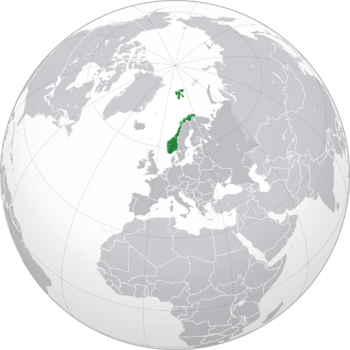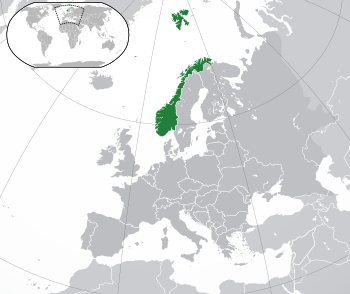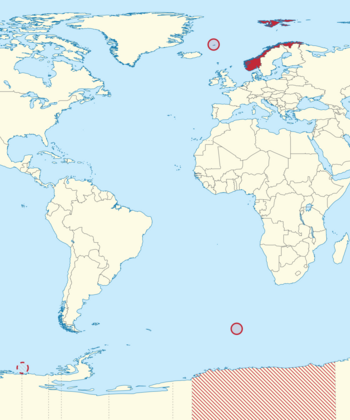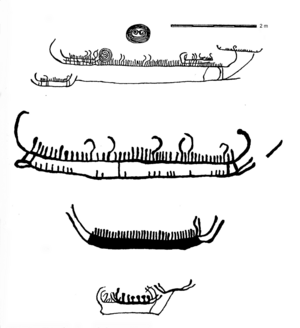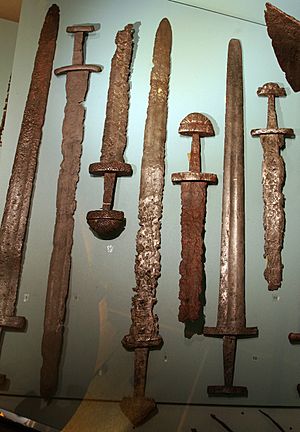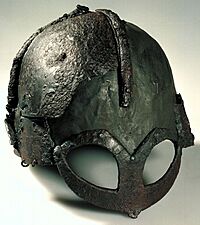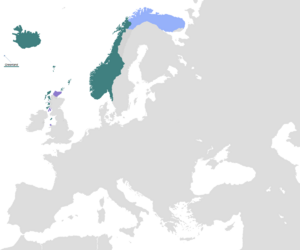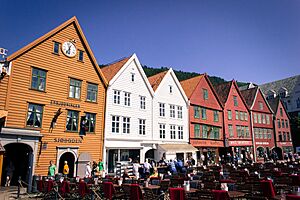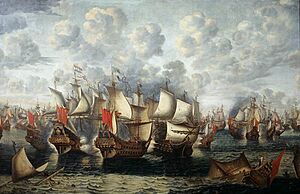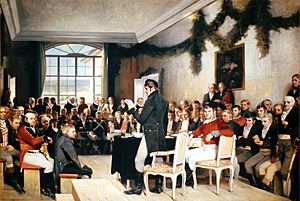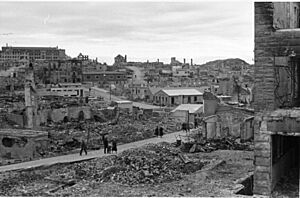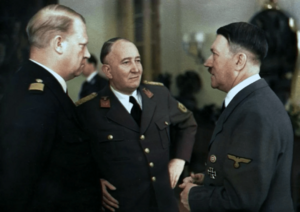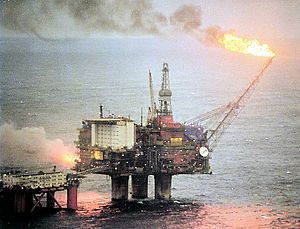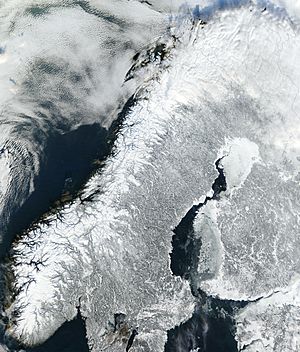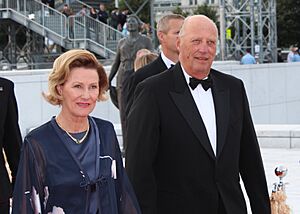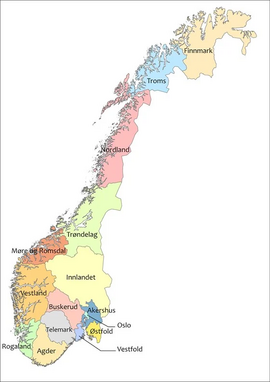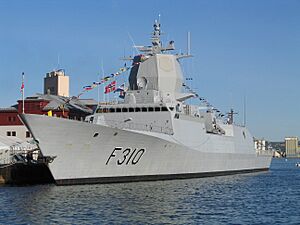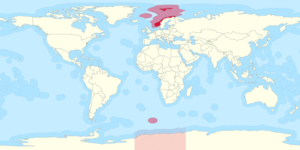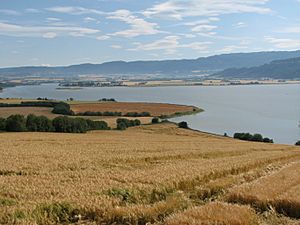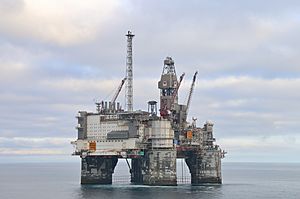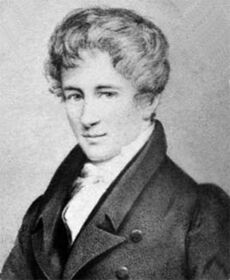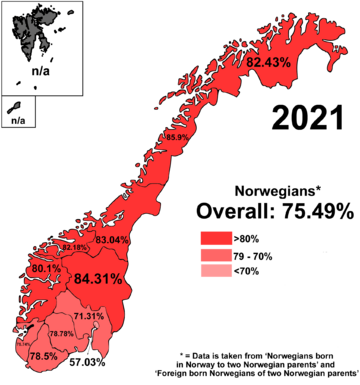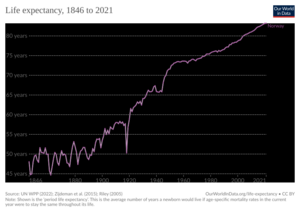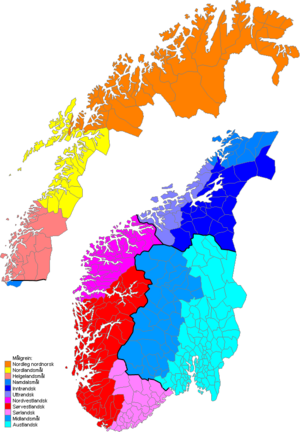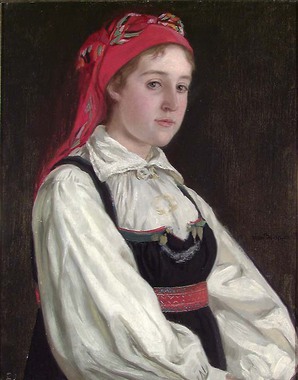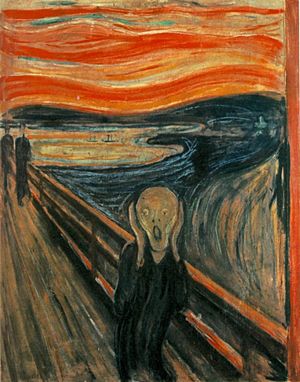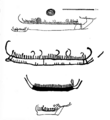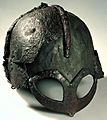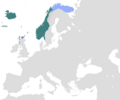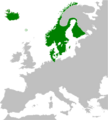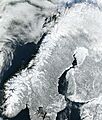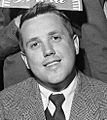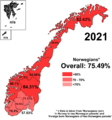Norway facts for kids
Quick facts for kids
Kingdom of Norway
Kongeriket Norge (Bokmål)
Kongeriket Noreg (Nynorsk)
|
|||||||||||
|---|---|---|---|---|---|---|---|---|---|---|---|
|
Location of the Kingdom of Norway (green)
on the European continent (green and dark grey) |
|||||||||||
| Capital and largest city
|
Oslo 59°56′N 10°41′E / 59.933°N 10.683°E |
||||||||||
| Official languages | |||||||||||
| Recognised national languages | |||||||||||
| Ethnic groups
(2021)
|
|
||||||||||
| Religion
(2024)
|
|
||||||||||
| Demonym(s) | Norwegian | ||||||||||
| Government | Unitary parliamentary constitutional monarchy | ||||||||||
|
• Monarch
|
Harald V | ||||||||||
| Jonas Gahr Støre | |||||||||||
|
• President of the Storting
|
Masud Gharahkhani | ||||||||||
| Legislature | Storting | ||||||||||
| Unification
of the petty kingdoms
|
|||||||||||
| 872 | |||||||||||
|
• Peak extent of the Old Kingdom
|
1263 | ||||||||||
|
• Kalmar Union (personal union)
|
1397 | ||||||||||
|
• Denmark–Norway (real union)
|
1524 | ||||||||||
|
• State re-established
|
25 February 1814 | ||||||||||
|
• Constitution
|
17 May 1814 | ||||||||||
|
• Kingdoms of Sweden–Norway (personal union)
|
4 November 1814 | ||||||||||
|
• Union dissolved
|
7 June 1905 | ||||||||||
| Area | |||||||||||
|
• Total
|
385,207 km2 (148,729 sq mi) (61stb) | ||||||||||
|
• Water (%)
|
5.32 (2015) | ||||||||||
| Population | |||||||||||
|
• 2025 estimate
|
|||||||||||
|
• Density
|
14.5/km2 (37.6/sq mi) (224th) | ||||||||||
| GDP (PPP) | 2025 estimate | ||||||||||
|
• Total
|
|||||||||||
|
• Per capita
|
|||||||||||
| GDP (nominal) | 2025 estimate | ||||||||||
|
• Total
|
|||||||||||
|
• Per capita
|
|||||||||||
| Gini (2020) | ▼ 25.3 low |
||||||||||
| HDI (2023) | very high · 2nd |
||||||||||
| Currency | Norwegian krone (NOK) | ||||||||||
| Time zone | UTC+1 (CET) | ||||||||||
|
• Summer (DST)
|
UTC+2 (CEST) | ||||||||||
| Date format | dd.mm.yyyy | ||||||||||
| Driving side | right | ||||||||||
| Calling code | +47 | ||||||||||
| ISO 3166 code | NO | ||||||||||
| Internet TLD | .nod | ||||||||||
|
|||||||||||
Norway, officially known as the Kingdom of Norway, is a Nordic country in Northern Europe. It is located on the Scandinavian Peninsula. The remote Arctic island of Jan Mayen and the archipelago of Svalbard are also part of Norway. Norway also has claims in Antarctica, including Peter I Island and Queen Maud Land.
Norway has a population of about 5.6 million people. Its capital and largest city is Oslo. The country covers a total area of about 385,207 square kilometers. Norway shares a long eastern border with Sweden. It is also bordered by Finland and Russia to the northeast. Norway has a very long coastline facing the Skagerrak strait, the North Atlantic Ocean, and the Barents Sea.
The unified kingdom of Norway was formed in 872. It was created by joining several smaller kingdoms. From 1537 to 1814, Norway was part of Denmark–Norway. Then, from 1814 to 1905, it was in a union with Sweden. Norway stayed neutral during the First World War. In the Second World War, it was invaded and occupied by Nazi Germany from April 1940 until the war ended.
Harald V is the current King of Norway. Jonas Gahr Støre has been the Prime Minister of Norway since 2021. Norway is a unitary state with a constitutional monarchy. Its government power is divided among the parliament, the cabinet, and the supreme court. This system is set by the 1814 constitution.
Norway has a Nordic welfare system. This means it has universal health care and a strong social security system. These systems are based on ideas of equality. The Norwegian government owns large parts of important industries. These include petroleum, natural gas, minerals, lumber, seafood, and fresh water. The petroleum industry makes up about a quarter of the country's GDP. Norway is one of the world's largest producers of oil and natural gas outside the Middle East. It has one of the highest incomes per person in the world. Norway also has the world's largest sovereign wealth fund, worth over US$1.3 trillion.
Contents
What's in a Name?
Norway has two official names: Norge in Bokmål and Noreg in Nynorsk. The English name "Norway" comes from an Old English word, Norþweg. This word was used around 880 and means "northern way" or "way leading to the north." It described the coastline of Atlantic Norway.
Some people believe the native name of Norway has the same meaning. It might have come from the Old Norse words norðr vegr, also meaning "the way northwards." This referred to the sailing route along the Norwegian coast.
A Look at Norway's Past
Early Times
The first signs of people in Norway are found along the coast. This is where the huge ice from the last ice age melted between 11,000 and 8000 BC. The oldest tools found are stone tools from 9500 to 6000 BC. They were found in Finnmark in the north and Rogaland in the southwest.
Around 3000 to 2500 BC, new settlers arrived in eastern Norway. These were farmers who grew grain and raised animals. They slowly replaced the hunting and fishing groups on the west coast.
Metal Ages
Around 1500 BC, people started using bronze. Burial mounds near the sea and inland in the south are from this time. They have rock carvings showing ships. Large stone burial sites shaped like ships were also built.
There is not much evidence from the early Iron Age (the last 500 years BC). During the first 400 years AD, people in Norway traded with Roman-controlled areas. About 70 Roman bronze pots have been found. Contact with southern countries brought knowledge of runes. The oldest known Norwegian runic writing is from the third century.
The Viking Age
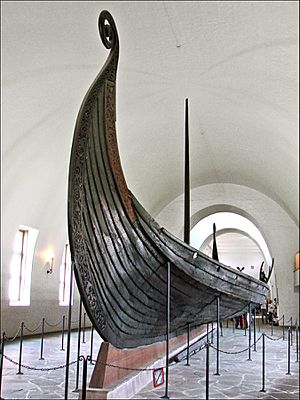
Around the 8th century, many small kingdoms existed in Norway. It is thought there were at least 20 across the country.
During the Viking period, Norwegian Viking explorers accidentally found Iceland in the ninth century. They were heading for the Faroe Islands. They later reached Vinland, which is now Newfoundland in Canada. Vikings from Norway were very active in the northern and western British Isles and islands in eastern North America.
Tradition says that Harald Fairhair united these kingdoms in 872 after the Battle of Hafrsfjord. He became the first king of a united Norway. Harald ruled strongly. Many Norwegians left the country to live in Iceland, the Faroe Islands, Greenland, and parts of Britain and Ireland.
Haakon I the Good was Norway's first Christian king in the mid-10th century. But his efforts to bring in Christianity were not accepted at first. Norse traditions were slowly replaced by Christian ones in the late 10th and early 11th centuries. This was largely due to kings like Olaf I Tryggvasson and Olaf II Haraldsson (St. Olaf).
The Middle Ages
From 1040 to 1130, Norway was peaceful. In 1130, a civil war started because the laws for who would be king were unclear. This allowed the king's sons to rule together. The wars ended in 1217 with Håkon IV Håkonsson becoming king. He made clear laws about who would inherit the throne.
From 1000 to 1300, the population grew from 150,000 to 400,000. This led to more land being farmed and farms being divided. By 1300, 70% of the land was owned by the king, the church, or rich families.
The 14th century is seen as Norway's golden age. There was peace and more trade, especially with the British Islands. In 1349, the Black Death arrived in Norway. It killed one-third of the population within a year. Later plagues reduced the population by half by 1400.
The Hanseatic League took control of Norwegian trade in the 14th century. They set up a trading center in Bergen. In 1380, Olaf Haakonsson became king of both Norway and Denmark. In 1397, the Kalmar Union was formed, joining Norway, Denmark, and Sweden.
Norway became less important under the Oldenburg dynasty (starting 1448). Norway did not take part in the events that led to Sweden's independence from Denmark in the 1520s.
The Kalmar Union
When King Haakon V died in 1319, Magnus Eriksson, who was only three, became King Magnus VII. He also became King of Sweden. So, Sweden and Norway were united under King Magnus VII.
The Black Death in 1349 killed between 50% and 60% of Norway's people. This led to a time of social and economic problems. Even before the plague, the population was only about 500,000. After the plague, many farms were left empty.
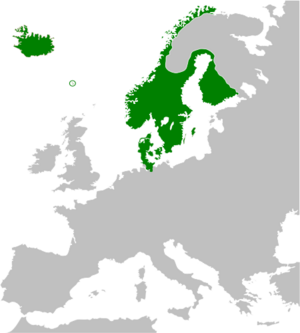
King Magnus VII ruled Norway until 1350. Then his son, Haakon, became Haakon VI. In 1363, Haakon married Margaret, daughter of King Valdemar IV of Denmark. When Haakon died in 1379, his 10-year-old son Olaf IV became king. Since Olaf was already King of Denmark, Denmark and Norway became a personal union.
Margaret wanted to unite Sweden with Denmark and Norway. But Olaf IV died suddenly. Denmark made Margaret temporary ruler. On February 2, 1388, Norway also crowned Margaret. She chose Eric of Pomerania, her sister's grandson, to be king. At a meeting in Kalmar, Erik of Pomerania was crowned king of all three Scandinavian countries. This brought Norway, Denmark, and Sweden under Queen Margaret's control in the Kalmar Union.
Modern History
Early Modern Period
After Sweden left the Kalmar Union in 1521, Norway tried to do the same. But their rebellion failed. Norway stayed in a union with Denmark until 1814. Some people called this time the "400-Year Night." This was because all of the kingdom's power was in Copenhagen.
When Protestantism was introduced in 1536, Norway lost its independence. It became like a colony of Denmark. The church's money and lands went to the court in Copenhagen. Norway lost its connection with the rest of Europe.
Norway became a kingdom again in 1661, but still in union with Denmark. Its land area became smaller in the 17th century. It lost areas like Bohuslän, Jämtland, and Härjedalen to Sweden after several wars. In the north, Norway gained Troms and Finnmark.
A severe famine from 1695 to 1697 killed about 10% of Norway's people. Harvests failed many times between 1740 and 1800, causing many deaths.
Later Modern Period
After Denmark–Norway was attacked by the United Kingdom in 1807, it joined forces with Napoleon. This led to very hard times and widespread hunger in 1812. In 1814, Denmark lost the war. It was forced to give Norway to Sweden by the Treaty of Kiel. However, Iceland, Greenland, and the Faroe Islands stayed with Denmark.
Norway used this chance to declare independence. It adopted a constitution based on American and French ideas. On May 17, 1814, Christian Frederick was elected king. This day is now celebrated as Syttende mai.
Norway did not want to be linked with Sweden. This led to the Norwegian–Swedish War. Sweden tried to take control of Norway by force. But Sweden's army was not strong enough to defeat Norway quickly. Norway also did not have enough money for a long war. British and Russian navies blocked the Norwegian coast. So, both sides had to negotiate the Convention of Moss.
Christian Frederik gave up the Norwegian throne. He allowed the Parliament of Norway to change the constitution. This allowed Norway to accept a personal union with Sweden. On November 4, 1814, the Parliament elected Charles XIII of Sweden as king of Norway. This created the union with Sweden. Under this union, Norway kept its constitution and its own independent groups. But it shared a king and foreign policy with Sweden.
This time also saw the rise of Norwegian romantic nationalism. Norwegians wanted to show their own national character. This movement affected literature, art, music, and even language. It led to today's two official written forms for Norwegian: Bokmål and Nynorsk.
In 1898, all men in Norway gained the right to vote. All women gained this right in 1913.
Dissolving the Union and World War I
Christian Michelsen, Prime Minister of Norway from 1905 to 1907, helped Norway separate peacefully from Sweden. This happened on June 7, 1905. A national vote showed that people preferred a monarchy over a republic. Prince Carl of Denmark was offered the throne. He was elected king by the Norwegian Parliament and took the name Haakon VII.
During the First World War, Norway remained neutral. However, pressure from the British government meant Norway favored the Allies. Norway exported fish to both Germany and Britain. But after British demands and anti-German sentiment due to German submarines attacking Norwegian ships, trade with Germany stopped.
World War II
Norway again declared neutrality during the Second World War. But German forces invaded on April 9, 1940. Norway was not ready for the surprise attack. However, military and naval resistance lasted for two months. Norwegian forces in the north fought against the Germans in the Battles of Narvik. But they had to surrender on June 10 after losing British support.
King Haakon and the Norwegian government went to London. During the war, they sent radio speeches and supported secret military actions against the Germans. On the day of the invasion, Vidkun Quisling, leader of a small National-Socialist party, tried to take power. But the German occupiers made him step aside. Real power was held by Josef Terboven, the head of the German occupation. Quisling later formed a government that worked with the Germans.
Many Norwegians joined the Allied forces. A small group left Norway with their king for Britain in June 1940. This group included 13 ships, five aircraft, and 500 men from the Royal Norwegian Navy. By the end of the war, this force had grown to 58 ships and 7,500 men.
During the German occupation, Norwegians built a resistance movement. This included civil disobedience and armed resistance. They destroyed Norsk Hydro's heavy water plant at Vemork. This greatly hurt the German nuclear program. The Norwegian Merchant Marine also played a very important role for the Allied war effort. It was the fourth-largest merchant fleet in the world. Every December, Norway gives a Christmas tree to the United Kingdom. This is to thank them for British help during the war.
After World War II
From 1945 to 1962, the Labour Party had a strong majority in parliament. The government, led by Prime Minister Einar Gerhardsen, focused on state-funded industrialisation. They also encouraged cooperation between trade unions and employer groups. Many state controls on the economy from the war continued.
Norway joined the North Atlantic Treaty Organization (NATO) in 1949. Oil was found in 1967. In 1969, the Phillips Petroleum Company found large oil resources at the Ekofisk field. In 1973, the Norwegian government started the state oil company, Statoil (now Equinor). Oil production did not bring in much money until the early 1980s.
Norway was asked twice to join the European Union. But Norwegians voted against it in referendums in 1972 and 1994.
In 2011, Norway suffered two terrorist attacks. These attacks hit the government area in Oslo and a youth summer camp on Utøya island. They resulted in 77 deaths.
Jonas Gahr Støre became prime minister on October 14, 2021.
Norway's Geography
Norway's main land area is the western and northern part of the Scandinavian Peninsula. The remote island of Jan Mayen and the Svalbard islands are also part of Norway. The Antarctic Peter I Island and the sub-Antarctic Bouvet Island are dependent territories. Norway also claims a part of Antarctica called Queen Maud Land.
Norway is in Northern Europe, between 57° and 81° N latitude, and 4° and 32° E longitude. It is the northernmost of the Nordic countries. Norway has the northernmost point on the European mainland. Its rugged coastline has huge fjords and thousands of islands. The coastline of the mainland, including fjords, stretches about 28,953 kilometers. When islands are included, it is estimated to be 100,915 kilometers.
Norway shares a 1,619-kilometer land border with Sweden. It also borders Finland (727 km) and Russia (196 km) to the east. To the north, west, and south, Norway is bordered by the Barents Sea, the Norwegian Sea, the North Sea, and Skagerrak. The Scandinavian Mountains form much of the border with Sweden.
Norway covers 385,207 square kilometers (including Svalbard and Jan Mayen). Much of the country is mountainous or high terrain. It has many natural features created by ancient glaciers. The most famous are the fjords. Sognefjorden is the world's second deepest fjord and the longest at 204 kilometers. The lake Hornindalsvatnet is the deepest lake in Europe. Norway has about 400,000 lakes and 239,057 registered islands.
Norway's Climate
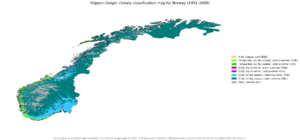
Because of the Gulf Stream and westerly winds, Norway has warmer temperatures and more rain than expected for its northern location. This is especially true along the coast. The mainland has four clear seasons. Winters are colder and drier inland. The northernmost part has a mostly maritime Subarctic climate. Svalbard has an Arctic tundra climate.
The southern and western parts of Norway get more rain and have milder winters. This is because they are open to Atlantic storms. Areas east of the coastal mountains are in a rain shadow. They get less rain and snow than the west. The lowlands around Oslo have the warmest summers. But they also have cold weather and snow in winter. The sunniest weather is along the south coast.
Because Norway is so far north, daylight changes a lot with the seasons. From late May to late July, the sun never fully sets north of the Arctic Circle. The rest of the country has up to 20 hours of daylight. From late November to late January, the sun never rises in the north. Daylight hours are very short in the rest of the country.
Amazing Biodiversity
Norway has more different habitats than almost any other European country. There are about 60,000 species in Norway and its waters. This does not include bacteria and viruses. The Norwegian Shelf marine area is very rich in life.
The species include 16,000 types of insects, 20,000 types of algae, 1,800 types of lichen, 1,050 types of mosses, and 2,800 types of vascular plants. There are also up to 7,000 types of fungi, 450 types of birds, 90 types of mammals, and 150 types of saltwater fish. About 40,000 of these species have been studied by scientists.
The largest predator in Norwegian waters is the sperm whale. The largest fish is the basking shark. On land, the largest predator is the polar bear. The brown bear is the largest predator on the Norwegian mainland. The largest land animal on the mainland is the elk (also known as moose).
Protecting the Environment
Norway has beautiful and dramatic scenery. The west coast of southern Norway and the coast of northern Norway have some of the most stunning coastal views in the world. National Geographic has called the Norwegian fjords the world's top tourist attraction. The country is also home to the Midnight sun (during summer) and the Aurora borealis (Northern lights).
The 2024 Environmental Performance Index ranked Norway seventh globally. This index looks at environmental risks to human health, habitat loss, and carbon dioxide emissions. Norway was the first country to ban deforestation. This was done to help prevent rainforests from disappearing.
How Norway is Governed

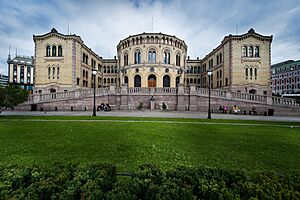
Norway is seen as one of the most developed democracies in the world. Since 2010, it has been ranked as the world's most democratic country by the Democracy Index.
Norway is a constitutional monarchy with a parliamentary system of government. The King of Norway is the head of state. The prime minister is the head of government. Power is divided among the legislative (parliament), executive (cabinet), and judicial (courts) branches. This is set by the 1814 Constitution.
The monarch officially holds executive power. But the King's duties are mostly symbolic and ceremonial. The Monarch is the commander-in-chief of the Norwegian Armed Forces. He also acts as the chief diplomat abroad and a symbol of national unity. Harald V became King in 1991. He is the first king born in Norway since the 14th century. Haakon, Crown Prince of Norway, is next in line to the throne.
In practice, the Prime Minister uses the executive powers. The Parliament of Norway, called the Storting, is the main law-making body. It can pass laws with a simple majority vote. The Storting has 169 representatives. 150 are elected directly from different areas. An extra 19 seats are given out nationwide to make sure all political parties are fairly represented.
The Prime Minister is usually the leader of the largest political party. Or, they lead a group of parties that work together. The Prime Minister chooses the cabinet members. These are usually from the same political party or parties in the Storting.
Norway has a state church, the Lutheran Church of Norway. It has been given more freedom in its daily work. But it still has a special status in the constitution. As of January 1, 2017, the Church of Norway is a separate legal group. It is no longer a part of the government.
Administrative Divisions
Norway is a unitary state. This means it is governed as one single unit. It is divided into fifteen main areas called counties (fylke). Each county has its own elected council and a County Mayor. The King and government also have a representative in each county called a County Governor.
Counties are then divided into 357 smaller areas called municipalities (kommuner). These are run by elected municipal councils, led by a mayor. The capital city of Oslo is both a county and a municipality.
Norway has two important overseas territories: Jan Mayen and Svalbard. Svalbard is the only developed island in its group.
Dependent Territories
Norway has three dependent territories in the Antarctic and Subantarctic regions. These are Bouvet Island, Peter I Island, and Queen Maud Land. On June 12, 2015, Norway officially claimed an area between Queen Maud Land and the South Pole.
Justice and Law Enforcement
Norway uses a civil law system. Laws are made and changed in Parliament. The system is managed by the Courts of justice of Norway. It includes the Supreme Court of Norway, appellate courts, city and district courts, and conciliation councils. The courts are independent from the government and parliament.
The law is enforced in Norway by the Norwegian Police Service. It is a single national police service with 27 Police Districts. It also has special agencies like the economic crime unit and the criminal investigation service.
Norway ended the death penalty for regular crimes in 1902. It ended it for war crimes in 1979. Norwegian prisons focus on helping people get better, not just punishing them. Norway's re-conviction rate (people committing crimes again) is one of the lowest in the world, at 20%.
Reporters Without Borders ranked Norway first out of 180 countries in its 2024 World Press Freedom Index. This means Norway has a very free press. The legal system in Norway is very open and honest. Corruption is very low.
Human Rights
Norway is seen as a country that supports human rights. It has laws and policies that help women's rights, minority rights, and LGBT rights. In 1884, the Norwegian Association for Women's Rights was founded. They worked for women's right to education, women's suffrage, and the right to work.
In 1990, Norway's constitution was changed. It now states that the oldest child, no matter their gender, will inherit the throne.
The Sámi people are native to the Far North. They have faced discrimination for centuries. However, in 1990, Norway was the first country to recognize the ILO-convention 169 on indigenous people.
Norway was the first country to have a law against discrimination that protects gay men and lesbians. In 1993, Norway allowed civil union partnerships for same-sex couples. On January 1, 2009, Norway became the sixth country to allow same-sex marriage.
Foreign Relations
Norway has embassies in 75 countries. 73 countries have embassies in Norway, all in Oslo.
Norway is a founding member of the United Nations (UN) and the North Atlantic Treaty Organization. It is also a member of the Council of Europe and the European Free Trade Association (EFTA). Norway applied to join the European Union (EU) three times. But Norwegian voters rejected joining in referendums in 1972 and 1994.
After the 1994 vote, Norway stayed a member of the European Economic Area (EEA). This gives Norway access to the EU's internal market. Norway has also joined the Schengen Agreement. This allows people to travel freely between many European countries without passport checks.
Military

The Norwegian Armed Forces have about 25,000 people. Norway has conscription, meaning some people are required to serve in the military. In 2013, Norway became the first country in Europe and NATO to draft women as well as men. The Armed Forces report to the Norwegian Ministry of Defence. The Commander-in-Chief is King Harald V.
Norway was one of the countries that started the North Atlantic Treaty Organization in 1949. Norway has helped in missions for the United Nations, NATO, and the European Union.
Norway's Economy
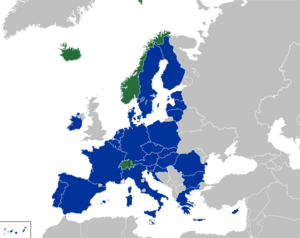
Norwegians have one of the highest incomes per person in Europe. Norway is the second wealthiest country in terms of money, with the largest capital saved per person. The CIA World Factbook says Norway is a net external creditor of debt. Norway was ranked first in the UNDP Human Development Index (HDI) in 2009. The standard of living in Norway is among the highest in the world.
The Norwegian economy is a mixed economy. It combines free market activity with large government ownership in key areas. Public healthcare in Norway is free for most people. Parents get 46 weeks of paid leave. The government gets a lot of money from oil production. As of July 2025, Norway has an unemployment rate of 3.9%.
The idea of equality in Norway means that the difference in pay between the lowest paid worker and a company's CEO is much smaller than in other Western countries.
The government owns large parts of important industries. These include oil (Equinor), hydroelectric energy (Statkraft), aluminum (Norsk Hydro), the largest bank (DNB), and telecommunications (Telenor). Norway is also a major shipping nation. It has the world's sixth largest merchant fleet.
Norway is rich in natural resources. These include petroleum, hydropower, fish, forests, and minerals. Large amounts of oil and natural gas were found in the 1960s. This led to a big economic boom. Norway has one of the highest living standards in the world partly because of its many natural resources compared to its population size.
Natural Resources
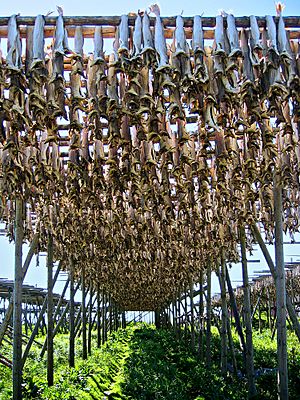
Oil and Gas Industry
Money from oil and gas exports makes up over 40% of all exports. It is almost 20% of the country's GDP. Norway is the fifth-largest oil exporter and third-largest gas exporter in the world. But it is not a member of OPEC. In 1995, the Norwegian government created a special fund called the "Government Pension Fund – Global." This fund is filled with money from oil revenues.
The government controls its oil resources. It owns a large part of major oil companies like Equinor. It also owns the fully state-owned Petoro. The government also controls who can explore for and produce oil. The fund invests in financial markets outside Norway. Spending from the fund is limited to a small percentage of its total value.
Norway is also the world's second-largest exporter of fish. Fish from farms and fishing are the second largest export product after oil and natural gas. Norway is the world's largest producer of salmon.
Hydroelectric plants create about 98–99% of Norway's electricity. This is more than any other country.
Norway has many mineral resources. In 2013, its mineral production was worth US$1.5 billion. The most valuable minerals are calcium carbonate, building stone, iron, and titanium.
In 2017, the Government Pension Fund had assets worth over US$1 trillion. This is about US$190,000 per person. It is the largest sovereign wealth fund in the world.
Transportation
Norway's public transport is less developed than in many European countries. This is because of its low population density and long coastlines. The country has a long history of water transport. But in recent years, the government has worked to improve rail, road, and air transport.
Norway's main railway network has about 4,114 kilometers of lines. In 2023, the railways carried 78.2 million passengers.
Norway has about 95,120 kilometers of roads. About 72,033 kilometers are paved. The most important national roads are part of the European route system. The two main ones are the European route E6, which goes north–south, and the E39, which follows the West Coast.
Norway has the world's largest number of electric vehicles per person. In March 2014, Norway was the first country where more than 1 in every 100 passenger cars was electric. The share of new car sales that are electric is also the highest in the world.
Of Norway's 146 airports, 52 are public. Oslo Airport, Gardermoen is the main airport. It is a hub for the two major Norwegian airlines: Scandinavian Airlines and Norwegian Air Shuttle.
Research and Innovation
Norway has a rich history of contributions to science, mathematics, and technology. Many Norwegian scientists and innovators are known worldwide.
In mathematics, Niels Henrik Abel and Sophus Lie made big discoveries. Caspar Wessel was the first to describe vectors and complex numbers. Atle Selberg, a major mathematician, won the Fields Medal.
In physics, Kristian Birkeland studied the aurora borealis. Ivar Giaever won a Nobel Prize in physics. Meteorologists Vilhelm Bjerknes and Ragnar Fjørtoft helped develop numerical weather prediction.
Norwegian chemists like Lars Onsager and Odd Hassel won Nobel Prizes. Peter Waage and Cato Maximilian Guldberg created the law of mass action, which is key to chemistry.
In technology, Håkon Wium Lie helped create Cascading Style Sheets (CSS) for web design. Pål Spilling helped develop the Internet Protocol, bringing the Internet to Europe. Computer scientists Ole-Johan Dahl and Kristen Nygaard created Simula, the first object-oriented programming language. They won the Turing Award.
As of 2024, Norway is ranked 21st in the Global Innovation Index. The country has produced fourteen Nobel Prize winners.
Tourism in Norway
In 2019, Norway ranked 20th in the World Economic Forum's Travel and Tourism Competitiveness Report. Tourism made up 4.2% of Norway's economy in 2016. One in every fifteen people in Norway works in tourism. Most tourists visit Norway between May and August.
Norway's main attractions are its varied landscapes. These include its coastline, mountains, ski resorts, lakes, and woods. Popular places to visit include Oslo, Ålesund, Bergen, Stavanger, and Trondheim. Much of Norway's nature is untouched. This attracts many hikers and skiers. The fjords, mountains, and waterfalls in Western Norway and Northern Norway attract hundreds of thousands of tourists each year.
In the cities, cultural sites like the Holmenkollen ski jump in Oslo and Bryggen in Bergen attract many visitors.
People and Culture
Population and Migration
Norway's population was 5,585,044 people in late 2024. Norwegians are a North Germanic people. The average number of children born per woman in 2023 was 1.40. In 2024, the average age of Norwegians was 40 years.
The Sámi people are native to the Far North. They have traditionally lived in central and northern Norway and Sweden. Another national minority is the Kven people. They are descendants of Finnish-speaking people who moved to northern Norway.
In 2017, Norway's population ranked first on the World Happiness Report. In 2025, it ranked seventh.
In the 19th century, many Norwegians moved to the United States and Canada. They could find work and buy land there. In 2006, almost 4.7 million people in the US said they were of Norwegian descent. This was more than the number of ethnic Norwegians in Norway itself. In 2021, 466,500 Canadian citizens said they had Norwegian ancestry.
In 2024, about 931,081 people (16.8% of the population) in Norway were immigrants. The largest groups of immigrants have come from Poland, Lithuania, Sweden, Syria, and Ukraine. Immigrants have settled in all Norwegian municipalities. In 2013, Oslo (32%) and Drammen (27%) had the highest share of immigrants.
Religion in Norway
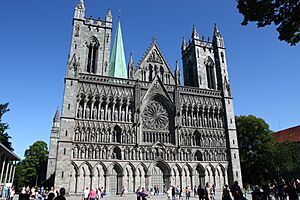
The separation of church and state happened later in Norway than in most of Europe. On January 1, 2017, Norway made the Church of Norway independent of the state. But it kept the Church's status as the "people's church."
Most Norwegians are registered as members of the Church of Norway when they are baptized. Many stay in the church to take part in events like baptism, confirmation, marriage, and burial. About 61.7% of Norwegians were members of the Church of Norway in 2024.
Religious Groups
Official religious affiliation in Norway (31 December 2019): Evangelical Lutheran Church of Norway (68.68%) Catholic Church (3.08%) Pentecostal congregations (0.76%) Eastern Orthodox and Oriental Orthodox (0.53%) Evangelical Lutheran Free Church (0.36%) Other Christian denominations (2.21%) Islam (3.41%) Buddhism (0.40%) Hinduism (0.21%) Secular Humanism (1.85%) Unaffiliated (18.32%) Other Religion (0.09%)
In 2010, 22% of Norwegians said they believed in God. 44% believed in some kind of spirit or life force. 29% did not believe in any spirit, God, or life force.
Islam is the largest non-Christian religion. It had 166,861 registered members in 2018. Other religions include Hinduism and Buddhism. About 1.7% of Norwegians belong to the secular Norwegian Humanist Association.
Health and Well-being
Norway was ranked first in the UN's Human Development Index (HDI) for 2013. Public health has improved a lot since the 1900s. This is due to better living conditions, changes in diseases, and a stronger healthcare system. Vaccination and antibiotics have greatly improved health.
In 2024, the infant mortality rate was 2.1 per 1,000 live births. This is the lowest rate ever recorded for boys in Norway.
Education System
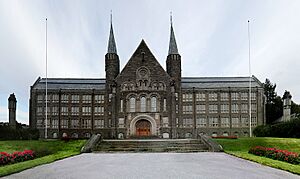
Higher education in Norway is offered by seven universities, five specialized colleges, and 25 university colleges. Education follows the Bologna Process. This includes Bachelor (3 years), Master (2 years), and PhD (3 years) degrees. You can get into higher education after finishing upper secondary school.
Public education is mostly free for students from EU/EEA countries and Switzerland. However, other international students need to pay tuition fees since 2023. The school year has two semesters, from August to December and January to June. The Norwegian Ministry of Education and Research is in charge of education.
Languages Spoken
Norwegian, in its two forms (Bokmål and Nynorsk), is the main official language of Norway. Sámi, a group of three related languages, is a recognized minority language. It is also an official language in certain areas of Northern Norway. Kven is another minority language.
Norwegian Language
Norwegian is a North Germanic language. It comes from Old Norse. It is spoken by over 5 million people mainly in Norway. It is generally understood across Scandinavia. It has two official written forms: Bokmål and Nynorsk. Both are used in public life, schools, and media. Bokmål is used by about 85% of people. About 95% of the population speak Norwegian as their first language.
Norwegian is closely related to Danish and Swedish. These three languages form a larger language community with about 25 million speakers. People from Scandinavian countries can usually understand each other.
Sámi and Kven Languages
Several Uralic Sámi languages are spoken by the Sámi people. They are mainly spoken in Northern Norway. About 15,000 people are officially registered as Sámi. But the number of people with Sámi heritage is estimated at 50,000. Only a minority are native speakers of Sámi languages. Most people of Sámi heritage now speak Norwegian.
Speakers of Sámi have the right to be educated and receive government communication in their own language in special areas. The Kven minority historically spoke the Uralic Kven language. Today, most ethnic Kven people do not know the language. The Kven language, along with Romani and Scandoromani language, are officially recognized minority languages.
Other Languages
English is the main foreign language taught in Norwegian schools. Most Norwegians, especially those born after World War II, speak English well. German, French, and Spanish are also commonly taught. 90% of Norwegians are fluent in English.
Norwegian Culture
Norwegian farm culture still plays a role in modern Norwegian culture. In the 19th century, it inspired a strong romantic nationalistic movement. This is still seen in the Norwegian language and media. Norwegian culture grew with efforts to create an independent identity in literature, art, and music. This continues today with government support for cultural projects.
Norwegian Cinema
Norwegian cinema has gained international attention. The documentary film Kon-Tiki (1950) won an Academy Award. The Pinchcliffe Grand Prix (1975) is an animated film and the most watched Norwegian film ever. Nils Gaup's Pathfinder (1987), about the Sámi, was nominated for an Oscar.

Since the 1990s, the film industry has grown. Elling and the 2012 film Kon-Tiki were nominated for Oscars. The TV series Skam became very popular worldwide.
Norwegian directors like Joachim Rønning, Espen Sandberg, Liv Ullmann, and Morten Tyldum have made successful international movies. These include The Imitation Game, Passengers, and Pirates of the Caribbean: Salazar's Revenge. Composers like Thomas Bergersen have worked on films like Avatar and The Dark Knight.
Norway has been a filming location for Hollywood movies. These include Star Wars The Empire Strikes Back (1980), No Time to Die, and Mission: Impossible – Fallout.
Music in Norway
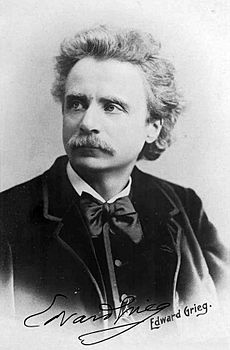
The classical music of romantic composers like Edvard Grieg is known worldwide. Norway's classical performers include pianist Leif Ove Andsnes and cellist Truls Mørk.
The jazz scene in Norway is very active. Jan Garbarek and Terje Rypdal are known internationally. Norway has a strong folk music tradition that is still popular.
Norwegian black metal, a type of rock music, has influenced world music since the late 20th century. Bands like Emperor and Mayhem are well-known.
Notable female solo artists include Susanne Sundfør, Sigrid, and Aurora Aksnes. Norwegian songwriters and producers like Stargate have worked with international artists.
Norway has often competed in the Eurovision Song Contest. It has won three times: in 1985, 1995, and 2009. Alexander Rybak's win in 2009 with "Fairytale" was a big success.
Norway hosts many music festivals throughout the year. Ekstremsportveko is one of the world's biggest extreme sport festivals with music. Oslo hosts festivals like Øyafestivalen and by:Larm.
Norwegian Literature

The history of Norwegian literature begins with ancient Norse poems from the ninth and tenth centuries. When Christianity arrived around 1000, Norway connected with European learning. This influenced literature in the late 12th and early 13th centuries.
Little Norwegian literature was written during the unions with Denmark and Sweden (1387–1814). This was because Danish was the official written language.
Two big events helped Norwegian literature grow again. In 1811, a Norwegian university was started in Oslo. In 1814, Norway created its first Constitution. Authors became known first in Scandinavia, then worldwide. These included Henrik Wergeland and Camilla Collett.
In the late 19th century, during the "Golden Age" of Norwegian literature, four great writers emerged: Henrik Ibsen, Bjørnstjerne Bjørnson, Alexander Kielland, and Jonas Lie. Henrik Ibsen is famous for his realistic plays like The Wild Duck and A Doll's House.
In the 20th century, three Norwegian novelists won the Nobel Prize in Literature: Bjørnstjerne Bjørnson in 1903, Knut Hamsun in 1920, and Sigrid Undset in 1928.
Architecture Styles
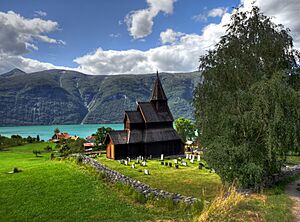
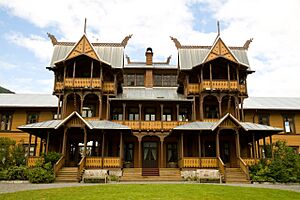
Norway has many forests, so building with wood has a long tradition. Many new buildings today are still made of wood.
When Norway became Christian, churches were built. Stone architecture came from Europe for important buildings, like the Nidaros Cathedral in Trondheim. In the early Middle Ages, wooden stave churches were built across Norway. Some still exist today. The Urnes Stave Church is a UNESCO World Heritage Site. Another example of wooden architecture is the buildings at Bryggen Wharf in Bergen.
In the 17th century, cities like Kongsberg and Røros were founded. Kongsberg had a church built in the Baroque style. Traditional wooden buildings in Røros have survived.
After Norway's union with Denmark ended in 1814, Oslo became the capital. Architect Christian H. Grosch designed early parts of the University of Oslo and the Oslo Stock Exchange.
In the early 20th century, the city of Ålesund was rebuilt in the Art Nouveau style. The 1930s were a strong period for Norwegian architecture. Only since the late 20th century have Norwegian architects become known internationally. The Sámi Parliament in Kárášjohka is a striking modern building. Its debating room looks like a lavvo, a traditional Sámi tent.
Art in Norway
For a long time, Norwegian art was influenced by Germany, Holland, and Copenhagen. In the 19th century, a truly Norwegian art era began. It started with portraits and later with impressive landscapes. Johan Christian Dahl painted the landscapes of western Norway.
Norway's new independence encouraged painters to show their Norwegian identity. This was especially true for landscape painting by artists like Kitty Lange Kielland and Harriet Backer. Frits Thaulow and Christian Krohg were also important painters.
A very famous Norwegian artist is Edvard Munch. He was a symbolist/expressionist painter. He is world-famous for The Scream, which shows the anxiety of modern people. Other famous works by Munch include The Sick Child and Madonna.
Norwegian Food
Norway's food traditions show the influence of long seafaring and farming. Popular foods include salmon (fresh and cured), herring, trout, codfish, and other seafood. These are balanced with cheeses like brunost, Jarlsberg cheese, and gamalost. Breads, mostly dark, are also common.
Lefse is a Norwegian potato flatbread. It is usually topped with butter and sugar. It is often eaten around Christmas. Traditional Norwegian dishes include lutefisk, smalahove, pinnekjøtt, raspeball, and fårikål. A Norwegian specialty is rakefisk, which is fermented trout. The most popular pastry is vaffel.
Sports and Recreation
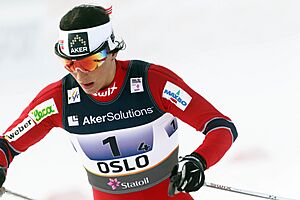
Sports are a big part of Norwegian culture. Popular sports include cross-country skiing, ski jumping, mountaineering, hiking, football, handball, biathlon, and speed skating.
Norway is known for developing modern winter sports, especially skiing. Since the 19th century, Norway has also been a top place for mountaineering.
Football is the most popular sport in Norway by active members. But in 2014–2015, biathlon and cross-country skiing were more popular to watch. Ice hockey was the biggest indoor sport in 2013. The women's handball national team has won many titles. These include two Summer Olympics championships (2008, 2012) and three World Championships.
In football, the women's national team won the FIFA Women's World Cup in 1995 and the Olympic Football Tournament in 2000. The men's national football team has played in the FIFA World Cup three times (1938, 1994, 1998).
Norway first took part in the Olympic Games in 1900. Norway leads the overall medal count at the Winter Olympic Games. Norway has hosted the Games twice:
- 1952 Winter Olympics in Oslo
- 1994 Winter Olympics in Lillehammer
It also hosted the 2016 Winter Youth Olympics in Lillehammer.
Chess has become very popular in Norway. Magnus Carlsen, a Norwegian, was the world chess champion from 2013 to 2023. Many big chess tournaments are shown live on national television.
Norway has produced many top track and field athletes. These include Andreas Thorkildsen (javelin throw), Grete Waitz (long distance running), and Jakob Ingebrigtsen (middle distance running).
Images for kids
See also
 In Spanish: Noruega para niños
In Spanish: Noruega para niños




